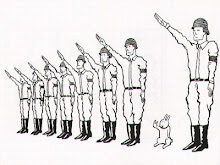The Emperor Has No Clothes
The problem with this fairy tale is that it stops too soon. The little boy convinces the villagers that the king is naked, but more than likely, the little boy faces ostracism and the populace and the king do all in their power to maintain the status quo and silence the little brat. Whistleblowers are not admired for their ethical or realistic views of a problem, but more often have their character besmirched.
The need for conformity is the desire to go along with the norms of a group of people, so you will be accepted as an in-group person - a non-threatening tribal animal. Conforming to group norms is a signal to the other group members that 'I am like you. I am following our rules. I am not a threat.' Sociologists study different groups for their different norms or rules to which group members conform in behavior, attitude, dress, language, etc. One study I read said that "In-group members who conform strongly are core group members who are asserting the identity of the group, or peripheral members who are trying to impress the core members, perhaps to be accepted into the 'inner circle' (which is in fact another group-within-the-group). Further out, people outside the group may similarly emulate group members either to seek admission to the group or to form an admiring group who are seeking to gain some reflected glory. An example is pop fans who dress like their idol."
Here are academic theories about forces encouraging conformity:
Bystander Effect: the more bystanders, the less likely it is one will help. In a famous study on conformity, Latané and Darley sat a series of college students in a cubicle amongst a number of other cubicles in which there were tapes of other students playing (the student thought they were real people). One of the voices cries for help and makes sounds of severe choking. When the student thought they were the only person there, 85% rushed to help. When they thought there was one other person, this dropped to 65%. And when they thought there were four other people, this dropped again to 31%.
A famous case occurred in the early 1960, where Kitty Genovese was attacked and eventually murdered over a 45 minute period during which 38 people witnessed the attack and did not lift a finger to help in any way.
Consistency Theory: we seek the comfort of internal alignment. Once we have made a declaration of our ethics, we try to remain consistent.
Commitment: we feel obliged to complete a public commitment.
Communication Accommodation Theory: we morph to be like others. When we talk with other people, we will tend to subconsciously change our style of speech (accent, rate, types of words, etc.) towards the style used by the listener. We also tend to match non-verbal behaviors. This signals agreement and liking.
Epistemological Weighting Hypothesis: conformance depends on how closely our norms match group norms.
Group Locomotion Hypothesis: members are motivated to achieve group goals.
Groupthink: maintenance of group cohesion becomes all-important.
Impression Management: we behave well when we are being watched.
Informational Social Influence: when we don't know what to do, we copy others.
Normative Social Influence: basic group need forces us to conform.
Pluralistic Ignorance: sometimes most people disagree with a group norm, but nobody speaks out.
Politeness Theory: we act politely or rudely depending on whether we care.
Reciprocity Norm: we need to return another's favor.
Roles: we conform with shared expectations of behavior.
Self-Fulfilling Prophecy: acting how we are treated.
Self-Monitoring Behavior: we are affected by how others see us.
Social Desirability Bias: we follow social rules when we are watched.
Social Impact Theory: how we behave depends on how many, etc. are watching.
Social Learning Theory: we learn much by watching others, thinking, then trying it out.
Social Norms: groups have rules that must be followed.
Spiral of Silence Theory: we keep quiet if we are in the minority (and vice versa)
Nobody remembers the name of the woman who tried to stop the accounting practices at Enron. Hugh C. Thompson, the U.S. Army helicopter pilot who helped expose the My Lai massacre in Vietnam more than 25 years ago and defied the soldiers on the ground by rescuing villagers, is hardly a household name and is less a hero to some than Lt Calley. Joseph Darby, the Army specialist who complained to his superiors about the torture of Iraqis in the Abu Graib prison is not interviewed on NBC. Whistleblowers are known to suffer greatly for their assertion that the "Emperor Has No Clothes."
Abu Graib reminds me of the famous experiment called the The Stanford Prison Experiment in 1973. Zimbardo set out to investigate whether prison guards were sadistic. There had been numerous stories in America in the 1960s about prisoners being brutalized, humiliated and even killed by their guards. In order to investigate if the guards behaved like that because of personality or environmental factors, Zimbardo set up an experiment at Stanford University using student volunteers. They became sadistic so quickly the experiment had to be stopped.


0 Comments:
Post a Comment
<< Home